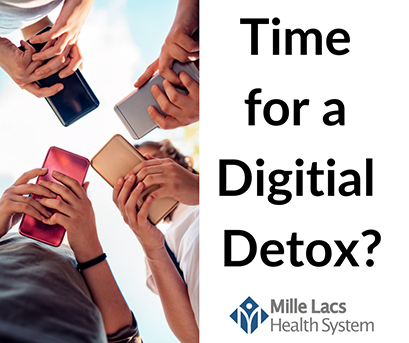Time for a digital detox?
July 19, 2024
What is a digital detox? It can be different for everyone. Typically, a “digital detox” refers to taking a break from digital devices such as smartphones, tablets, computers, etc. Maybe even television. Disconnect from the digital world to focus on experiences, relationships, and activities - additionally, a focus on more physical activity. Many people must use computers daily for work, and be available via smartphones to answer emails and texts, etc. The focus then can be how you spend your free time away from work. For young people (one of the heaviest users of digital) they are home for the summer, their schedules are likely pretty open and free of digital commitments. So kids are the prime candidates for digital detox.
There are many reasons why a digital detox and honest assessment of your screen time is a good idea. Overuse of digital devices usually means underuse of the body. The physical complications that most often occur from overuse of digital devices are finger, wrist, and forearm strain, eye strain, and neck & spine strain. Sadly, these hand-held devices haven’t been around long enough to truly understand the long-term effects that overuse can have on the body.
The mental and emotional complications that can go hand-in-hand with too much digital include: anxiety, depression, impaired relationships (at work, school, and even at home), behavioral problems, addictions, over-eating or unhealthy eating, over-spending on games, and lack of sleep. Additionally, weight gain, lack of time management, and low work ethic are other potential problems.
The digital world is very appealing. It can be educational, is very entertaining, but also addictive.
When considering a “digital detox” the first thing to note is the amount of time spent in front of a screen, what types of things are you watching or playing? How much time is interactive gaming, learning, or strictly entertainment or “mindless scrolling”?
Second, set reasonable and attainable goals for yourself in terms of the amount of time using digital, and choice of content.
If you’re getting ready to talk with a child, or friend about cutting back on their digital time remember that one of the most important things is to be a good role model yourself. So if you too could cut back on digital time make that commitment with them. Goals might be different, but you’re in it together.
Here are a few techniques to achieve digital detox: schedule times away from devices, or maybe schedule times that devices can only be used, place devices out of sight, create tech-free zones such as meal-time, and disconnect at least one hour before bed.
Without digital, what is there to do? It’s hard to break routines, so it’s important to come prepared with realistic ideas that will pique the interest of your child, or prepare a list for yourself of hobbies or activities to consider trying or revisiting.
Understand that for most the quitting “cold turkey” method of all or none does not often work or last long. Moderation is key. Even if there’s a slight cutback in the amount of time on digital devices, and a change in the type of games or content for the better it’s still a win.
